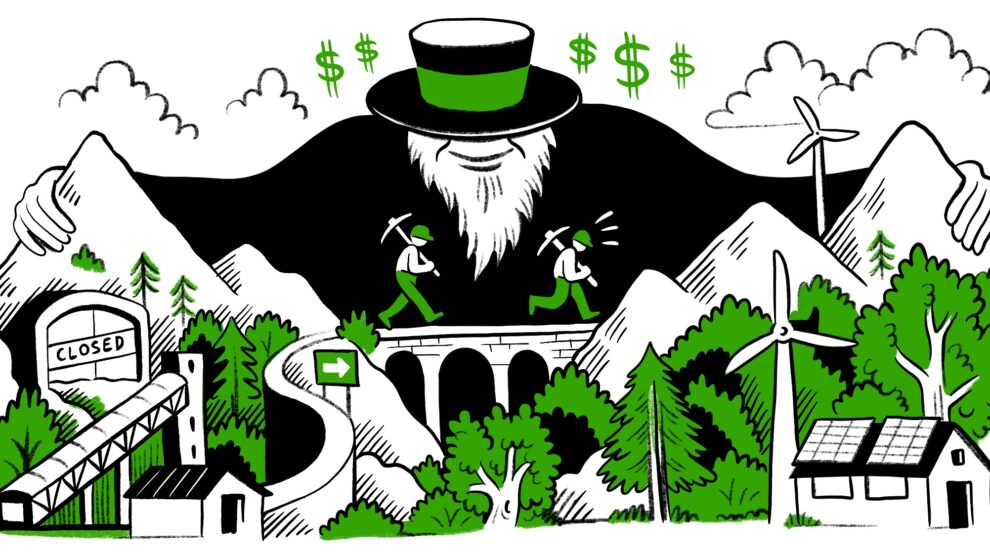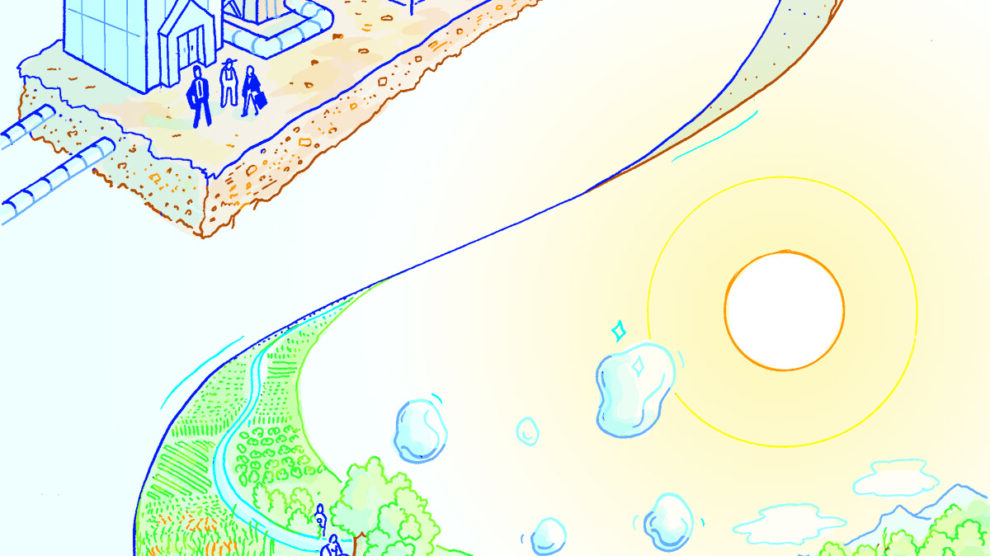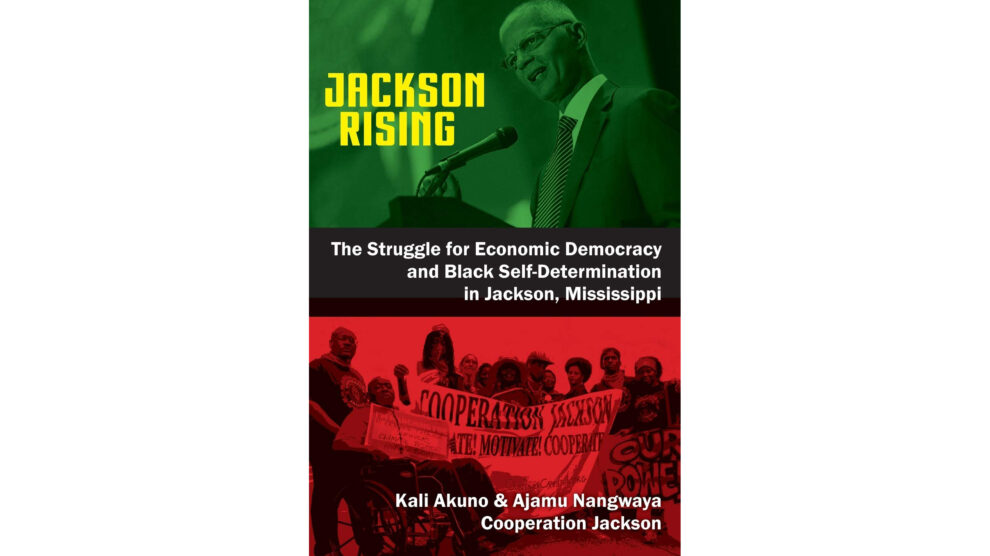Red Wine, A Fraying Order, and the Science Journalism We Need
By Bennett McIntosh
Volume 22, number 2, Envisioning and Enacting the Science We Need
It’s a jarring experience to have someone explain your job to you, especially if they get it wrong, and that’s just what happened during the opening remarks of the July 2019 World Conference of Science Journalists. A series of European politicians and a vice president of the ninth-most-valuable company in the world patiently and grandiosely described a practice that more resembles translation or stenography than journalism.
“[Science] needs champions like you all to put facts back in the driver’s seat,” said Seema Kumar, vice president of munificent repeat conference sponsor Johnson & Johnson Innovation. Eliding the investigative or critical roles of journalists is perhaps to be expected from a company that Reuters recently revealed had lied for decades about the asbestos content in its baby powder, but the government officials sharing the stage with Kumar took a similarly uncritical view of science—and seemed to expect journalists to do the same.1 European Commissioner Carlos Moedas even found room for some Trumpist nostalgia for colonial empire, proclaiming that “Europe was great only when science was great,” stopping just short of urging the people tasked with reporting objectively on science to Make Science Great (respected, dominant, unquestioned) Again.
This picture of science journalism as translating pure facts generated by a perfect, world-striding science is, fortunately, unrecognizable to most contemporary science journalists, who rightly espouse independence, objectivity, and critique. Taking the stage immediately after Kumar, science journalist and author Deborah Blum offered an improvised but eloquent defense of the journalist’s role as a watchdog, scrutinizing and criticizing science as much as championing it. The journalists—and even many press officers—in the room applauded.
But the line between “champions of science” and “watchdogs” is a permeable one. In part, this is because what some have called the “golden age” of journalism—when profitable city papers and glossy magazines had the resources and social capital to set standards of objectivity—is long past. But it is also because the old structures were never as objective as they purported, deferring broadly to the authority of elite scientific institutions.
Even through “post-truth” crises of authority, the journalist still wields substantial influence on public engagement with science, so considering where these values came from, and how the present moment will evolve or replace them, has great bearing on the development of a science truly for the people. How should those who place themselves as gatekeepers between science and the people “envision and enact the science journalism that we need?”
A Moral Shift
The relationship between science journalists and the institutions of science we cover is cozier than we usually admit in public. This is reflected in our professional societies—the National Association of Science Writers welcomes press officers from universities, government agencies, and even corporations as full members—and in our own careers. Especially for early career science journalists, it’s not uncommon to move back-and-forth across the journalism/ PR divide.2 As a freelancer myself, I make as much money writing web copy and social media posts for universities and nonprofits as I do selling reportage—though I try to be up front with who’s paying me to write about what—while freelancer friends of mine stay afloat with the benefit of day jobs or part-time gigs at for-profit publishing juggernauts (whose privatization of volunteer scientific labor is immensely profitable) or rich universities.3
Such arrangements will only become more common and more diverse as the economics of science journalism become starker. It’s simplistic to call this an inevitable decline and blame “The Internet” for lowering the barrier of entry and unbundling profitable classified advertising and weather reports from more expensive investigations. Private equity firms choose to plunder otherwise-healthy newspapers, and surveillance capitalism platforms like Facebook and Google choose to leach advertising revenues while putting news sites at the mercy of capricious algorithms.4 All these trends seem likely to continue, making the full-time journalist an increasingly rare creature.
Unsurprisingly, such moonlighting is controversial in the world of science journalism—many journalists of my own generation avoid it, veteran journalists approach it with reactions ranging from skeptical sympathy to uncomprehending revulsion, and related journalism societies—including the Society for Environmental Journalists and the American Healthcare Journalism Association—bar anyone currently or recently doing public relations work from full membership. But the individual and institutional bridges between writing for scientific institutions and writing about them have a history far longer than that of the current economic bind that writers like myself are in. It’s a history of journalistic institutions whose promises of objectivity were the exception to the longstanding rule—motivated by the particularities of the mid-century newspaper business—and were, however laudable, never fulfilled.
No View is From Nowhere5
The National Association of Science Writers was incorporated in 1955, in the midst of a post-war boom in the production of popular science writing. Its mission of promoting the “dissemination of accurate information regarding science” hides certain assumptions about popular science at the time.6
At the same time that American anti-communist efforts found it useful to construct an idealized, internationalist, and apolitical view of “scientific freedom” (a phenomenon ably explored by historian Audra J. Wolfe in Freedom’s Lab), newspapers found that the best way to draw more readers in their metropolitan markets was to provide something for everyone—weather reports, baseball scores, recipes, classifieds, and investigative journalism—which meant positioning themselves as objective, apolitical authorities.7 This “view from nowhere” reporting was not, of course, from nowhere— it favors the status quo, it reflects the whiteness, masculinity, and capitalist sensibilities of its elites, and its instincts for balance and (paradoxically) its deference to scientific authority are easily exploitable by what historians Naomi Oreskes and Erik Conway call “Merchants of Doubt” in their eponymous book. But soaring profits did allow newspapers to invest in expensive investigative reporting, which fed their authority as objective truth-seekers—an identity journalists then shared with scientists.8
This coincidence of professional values allowed journalists to see scientists as their natural allies, and to promote their worldview accordingly. In this post-war world, historian Bruce Lewenstein writes, “the term ‘public understanding of science’ became equated with ‘public appreciation of the benefits that science provides to society.’”9
Historically, perhaps only the daily crime reporting beat and the White House press corps rely so closely on a single source of authority—and even then, neither Sean Spicer nor police spokespeople make a habit of joining crime reporters journalists’ professional societies.10 This alliance frayed somewhat after the first decade of the Cold War, when the politics of science returned to the public’s mind with Rachel Carson’s Silent Spring, the resulting rise of environmental journalism, and the controversies around sociobiology, nuclear testing, and the Vietnam War which spawned this magazine.11
But the alliance didn’t end, and not just because of these historical ties. Every morning my inbox fills up with emails from various universities and scientific journals, giving me advance notice of scientific studies coming out in the following days. These stories are embargoed—I receive them on the condition that I don’t publicize the information until the journal article comes out. This has a noticeable effect on the rhythm of science journalism: keep an eye out and you’ll notice a bevy of stories about studies published by Nature on Wednesday afternoons and Science on Thursday afternoons.
Journalists, rushing to publish as soon after the embargo lifts as possible, have time to consult the studies’ authors, but seldom become conversant in the controversies they may be wading into or consult other perspectives—including patients and communities marginalized or colonized by the relevant research, and science studies scholars who can provide important context. Plenty of reporters take their role seriously, applying what context they can or even eschewing the weekly news cycle in favor of deeper, slower-breaking stories, putting misconduct, malfeasance, and controversy in context. But when uncritical reporting is so much easier—and has just as good a claim to “objectivity,” any critique that may exist in that weekly rush of stories from Nature and Science gets drowned in the flood of hype.
Such uncritical reporting damages the authority of science journalists, though not for the reasons a radical critic may hope. Reporting based on individual studies that turn out to be far less conclusive than they seem when presented alone results in whiplash reporting—red wine infamously seems equally likely to give us cancer as to cure it—that can only decrease scientists’ trust in journalists and the public’s trust in both.
The End of Objectivity
If both apolitical science and apolitical journalism (and especially their confluence) are illusory products of a time long past—what are we to do in the current moment? It’s trite by now to note that the internet’s vanishingly low barriers to entry—anyone can blog, anyone can tweet—have sapped legacy media’s monopoly on both advertising and authority. In science journalism, the old order has frayed even more, with preprints and open-access journals disrupting the old gatekeepers’ duopoly on scientific information.
The left is not, of course, alone in noticing that freer access to news and scientific information can serve our ends. Well-funded propaganda outlets that bear the trappings of “golden-age” objectivity—the “fair and balanced” Fox News, the “independent” Quillette—are joined by countless freelance actors looking for their own slice of scientific authority. The intersection between white supremacists and science, is, as always, fertile ground for race scientists.
“There’s a ubiquitous trend of white-nationalist-adjacent communities Tweeting about genetics papers,” says Jedediah Carlson, a postdoc and biostatistician at the University of Washington who has collected and mapped the ways such actors wield research to their own ends. “Some of the papers, some 40-50 percent of the tweets referencing them are coming from these white nationalist-adjacent accounts.”12
This has not gone uncontested among scientists. Trained geneticists like author and BBC broadcaster Adam Rutherford and Kevin Bird, a PhD student in plant genetics at Michigan State University, make a point of countering reactionary assertions wherever they find them, wielding both their scientific authority and their naked contempt. Bird can be found throughout Reddit and Twitter, mixing open mockery with extensive citations. “I think it’s important that people see someone with some level of authority, expertise, or prestige being derisive” of race science conclusions, says Bird.13
Scientists trolling Nazis in their free time is not a long-term solution, though. Bird, for one, bemoans the lack of institutional or organizational support for this work. While tenure-track faculty gain plaudits for being cited in traditional media, “this activity is potentially putting [my] future employment at risk someone could go to [the National Science Foundation] and try to pull my funding,” he says. “I’m less protected.”
Three Questions
If I knew where all this was going—if I knew how to turn the values and institutions of “golden age” science media into a way to survive under capitalism while promoting the project of radical science—I’d be doing that instead of writing this story. So, I hope this background opens a conversation about the role these structures can play in the struggle to build a science for the people. I end with three provocations:
Unbalanced News: If writers can report credibly about science while also working for scientific institutions, and reactionary outlets can present themselves as fair and balanced, how can we work to make unapologetically anti-capitalist writing a part of the science journalism and broader science communication landscape? How can journalist unions, politically minded scientists, and readers support this project?
Debunking Reactionary Science: Should science journalists, museum workers, scientists who write, and others join scientists like Bird and Rutherford in the figurative trenches to leave no white nationalist meme uncontested? How can we build organizational support for those who do this, whoever they are, and how can this be done strategically, countering the claims on platforms where, by design, argumentation is amplification?
Science With the People: In the 1950s, science journalists told science stories because they decided the public ought to be interested in their vision of science, and therefore assumed that it was true. How can science journalists, and anyone else who takes it upon themselves to intercede between science and the people, ensure that the stories they’re telling are the stories that matter to their audience, and that allow us to democratically shape the direction of science for the future?
I don’t know the answer to these questions. But I’m glad that, with the return of Science for the People, I’m not asking them alone.
About the Author
Bennett McIntosh is a freelance science writer and reporter based in Boston, Massachusetts.
References
- Lisa Giron, “J&J Knew for Decades That Asbestos Lurked in Its Baby Powder,” Reuters, December 14, 2018.
- Aleszu Bajak, “The (Grim) Economics of Being a Young Science Writer,” Undark, October 26, 2016.
- Clients this year include Princeton University (writing about materials science, water systems, and carbon utilization), Florida State University (solid state physics), the University of Georgia (computational chemistry) and the Fannie and John Hertz Foundation (a monthly newsletter on the doings of various fellows the Foundation has funded, and longer stories on biogeochemistry, communicating about climate, DARPA, and dark matter).
- Denver Newspaper Guild, “A Message to Alden Global Capital: Sell the Denver Post Now!,” March 15, 2018.
- I owe this pithy phrasing to security journalist Kelsey Atherton; Steven Maras, Objectivity in Journalism (Cambridge, UK: Polity Press, 2013), 77-81.
- National Association of Science Writers. “Final Report of the NASW Constitutional Review Ad Hoc Committee,” May 16, 2016. For an example of how this tension plays out in the contemporary organization, see Mnookin, “A Vote to Determine the Future of Science Journalism.”
- Audra Wolfe, Freedom’s Laboratory: The Cold War Struggle for the Soul of Science (Baltimore: Johns Hopkins University Press, 2018); Heidi Tworek and John Maxwell Hamilton, “Why the ‘Golden Age’ of Newspapers Was the Exception, Not the Rule,” Nieman Lab (blog). May 2, 2018.
- Tworek and Hamilton, “Golden Age.”
- Bruce V Lewenstein, “The Meaning of ‘Public Understanding of Science’ in the United States after WWII,” Public Understanding of Science, no. 1 (1992): 45–68.
- Sophie Haigney, “Down with the Daily Crime Story,” Popula, July 24, 2018; John Allsop, “Killing the White House Correspondents’ Dinner,” Columbia Journalism Review, April 26, 2019.
- I owe much of this analysis to Lewenstein’s history and Aaron Panofsky’s Misbehaving Science. It’s worth noting here that the society of environmental journalists, founded in 1990 does not allow press officers, even of conservation organizations, full membership; Aaron Panofsky, Misbehaving Science: Controversy and the Development of Behavior Genetics (Chicago: University of Chicago Press, 2014).
- Jedediah Carlson, phone interview, May 2019.
- Kevin Bird, Skype interview, November 2018.





